
Bodies Transformed: Drawing
Constance Sheares
This document is part of a joint project of the NUS Museums and the University Scholars Programme, National University of Singapore. This image and accompanying text appears here with the kind permission of the NUS Museums. Note: click on any of the pictures in the following text to obtain additional information and larger images, which take longer to download.
Bewitched and the Sitting Pretty series lead naturally to the Torso-to-Face group of sculptures as the life drawings of this period. Eng Teng first began sketching from life in 1963 at the Farnham School of Art, but since returning to Singapore in 1966 he has had no opportunity to continue this practice until he joined Teng Nee Cheong's private life drawing sessions in 1990 and then Group 90 in 1991. This 'club' was initiated by Namasivayam in 1990, with the participation of other retired art teachers - Chia Wai Hon and Sim Tong Kern and a few others - for the sole purpose of drawing from life every Saturday at LaSalle-SIA College of the Arts.
Eng Teng's life drawings are meticulously crafted in heightened flesh tones, using coloured pencils. They are fair-sized, 'finished' works, made for themselves, containing all the elements from exploratory beginnings to the complete statement in the one work. They are not academic in the formal sense, but powerful, sensitive and humanist. The artist explains, "I try to make the figures as sensitive and sensual as possible and that, to me, is the purpose of having a model. There is no point for an artist to have a model and then paint a figure in pure abstract form or just splashes of colour. I feel that is just wasting time and money. You don't need a model if you are doing it that way, you can create that kind of image in your mind. When I have a model in front of me, I have to be 'truthful' to the subject. So what I try to do is to put life and bring out the spirit of the sitter, apart from concentrating on technique."
The earlier drawings, such as Malvis I, 1991 (Fig. 45), are mostly characterised by relaxed forms, executed by means of delicate lines and intricate shading, employed to catch the poses of the figures. Colour and texture play almost as important a part in the effectiveness of the image as the pencil marks themselves. The use of coloured pencils enables Eng Teng to render the flesh tones and to achieve a richness and delicacy of treatment impossible in other graphic media. "With coloured pencils, at least, you can try to depict the reality of the subject. But it is still impossible, even with coloured pencils, to depict life and flesh. No matter how much you try, it will be difficult."
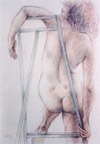
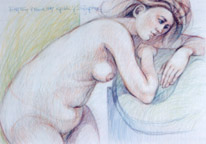 In The Easel, 1992 (Fig. 46) there is still a softness of modelling, a delicacy of touch and a fineness of line in negotiating the body features. These female forms often display a mannerist idealisation of the figure, with full features, rounded and sinuous contours. The Expectant, 1997 (Fig. 47), rather reminiscent of Ingres in its stylisations, is another example. Soon, however, the delicate strokes and the fine lines, close together, give way to bolder, more fluent markings and dense cross-hatching to create a greater sense of three-dimensional form, as in Sleeping Woman I, 1993 (Fig. 48). There is also an attempt at foreshortening and more complex poses.
In The Easel, 1992 (Fig. 46) there is still a softness of modelling, a delicacy of touch and a fineness of line in negotiating the body features. These female forms often display a mannerist idealisation of the figure, with full features, rounded and sinuous contours. The Expectant, 1997 (Fig. 47), rather reminiscent of Ingres in its stylisations, is another example. Soon, however, the delicate strokes and the fine lines, close together, give way to bolder, more fluent markings and dense cross-hatching to create a greater sense of three-dimensional form, as in Sleeping Woman I, 1993 (Fig. 48). There is also an attempt at foreshortening and more complex poses.
In contrast to his languid female forms with their soft modelling and elegant lines, Eng Teng's later male nudes have a solid sculptural quality, as in Rear View III, 1992 (Fig. 49), where contours of the musculature of the back are rendered in precise, loosely worked hatchings. Shapes are drawn and redrawn in search of the definitive form. The concentrated clusters of hatched lines effectively break up the surface of the drawing into the planes of the body.
Eng Teng was soon able to throw off the mannerisms of academic draughtsmanship for a style that is more abstract and individual, as in Woman's Back, 1993 (Fig. 50), which is a wonderful combination of rhythmic abstraction with the skills of representing texture and surface. Some of these drawings, although complete works of art in themselves, were used to record and analyse forms which he later developed into sculptural works. Abstract Torso I, II and III, 1992 (Figs. 51, 52 and 53), for instance, became the working drawings for a series of sculptures which includes Bewitched and Small Eyes. For him, drawing served many functions, as a way of working out ideas, as a way of looking hard at a detail to be used in a sculpture, and as a way of setting the imagination free. He was primarily concerned with sculptural mass rather than with making images objectively 'right'. He was interested in it as the product of his observation and his imagination and a realisation of his inner ideas. It is a means for working through to a personal vision, and he is determined to develop his skill to the point where drawing allows him to express the impulses from within to achieve depth and surprise.
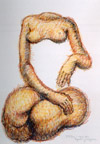
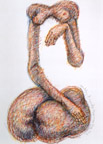
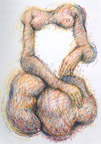
These drawings show the amount of work Eng Teng put into the evolution of his style. They are the result of ceaseless observation and intense involvement with his subject. He had started with stiffly academic life studies of his student days at Farnham and has won through to something freer and more profound and personal, drawing more from his feelings than with a view to anatomical accuracy.
References
Constance Sheares. Bodies Transformed: Ng Eng Teng in the Nineties. Singapore: NUS Museums/ National University of Singapore, 1999.






Last updated: 11 January 2001

 In The Easel, 1992 (Fig. 46) there is still a softness of modelling, a delicacy of touch and a fineness of line in negotiating the body features. These female forms often display a mannerist idealisation of the figure, with full features, rounded and sinuous contours. The Expectant, 1997 (Fig. 47), rather reminiscent of Ingres in its stylisations, is another example. Soon, however, the delicate strokes and the fine lines, close together, give way to bolder, more fluent markings and dense cross-hatching to create a greater sense of three-dimensional form, as in Sleeping Woman I, 1993 (Fig. 48). There is also an attempt at foreshortening and more complex poses.
In The Easel, 1992 (Fig. 46) there is still a softness of modelling, a delicacy of touch and a fineness of line in negotiating the body features. These female forms often display a mannerist idealisation of the figure, with full features, rounded and sinuous contours. The Expectant, 1997 (Fig. 47), rather reminiscent of Ingres in its stylisations, is another example. Soon, however, the delicate strokes and the fine lines, close together, give way to bolder, more fluent markings and dense cross-hatching to create a greater sense of three-dimensional form, as in Sleeping Woman I, 1993 (Fig. 48). There is also an attempt at foreshortening and more complex poses.


